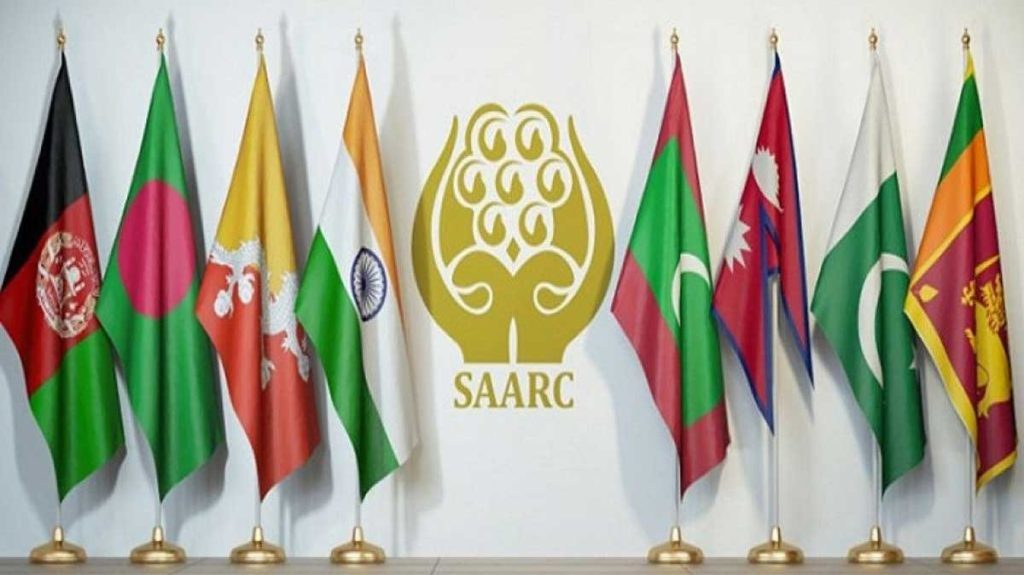Introduction
Authorities around the globe are rushing to craft rules and regulations for the use of AI technologies, sparking excitement and fear about their potential to transform various sectors. South Asian region, where the ongoing strategic conflict between India and Pakistan, a lack of consensus among regional countries, and the inactive role of the South Asian Association for Regional Cooperation (SAARC) have complicated the regional security environment, especially in the face of emerging AI challenges.
In this context, SAARC can establish unified guidelines for AI governance, especially to mitigate its potential risks. This would help balance the development of technology with the risks linked to it. The guidelines would also serve as practical and actionable measures to support the region’s robust implementation of advanced AI technologies. SAARC nations have made significant progress in AI for domestic development, especially in health, agriculture, education, and governance. However, challenges related to digital infrastructure literacy and socioeconomic gaps enhance the risks of misuse, especially in managing the AI risks in the military dynamics between India and Pakistan. This situation is further complicated due to deep-rooted mistrust, political conflict, and fears of strategic losses.
In South Asia, both the advantages and challenges linked with AI usage emphasize the need for effective mechanisms that can mitigate threats, foster innovation, and encourage cooperation. In the digital era, collaborative efforts and mechanisms are vital for effective regulations, implementation, and safeguarding sovereignty and human rights. Additionally, the steps to establish AI policies should be aligned with the regulatory frameworks of other technologically advanced countries such as the US, China, ASEAN, the EU, and the UN.
Lessons for SAARC
United States (US)
SAARC can significantly benefit by collaborating with the US to regulate and prevent AI-related threats. SAARC members can engage more in policy exchanges with US agencies, such as the Federal Trade Commission (FTC) and the National Institute of Standards and Technology (NIST), while learning from these well-established AI governance frameworks. Capacity-building programs, Research and development collaboration with US educational and other related institutions can further support the development of ‘SAARC-specific risk assessment models to address AI-related challenges. Moreover, financial and technical support from the US could empower SAARC nations to create accountability frameworks for regional AI management and infrastructure, while collaboration with US firms to enhance PPPs would provide access to secure and ethical AI techniques.
Multilaterally, SAARC could promote participation in global AI initiatives led by the US, such as the “Global Partnership on AIâ€, and establish a SAARC-US dialogue to address regional AI issues. Based on best practices, such as the ‘Blueprint for an AI Bill of Rights’, Public awareness initiatives in collaboration with NGOs and educational institutions in the US can promote responsible use of AI and counter misinformation. Joint efforts can also address mutual challenges. However, the recent move by President Trump to revoke AI-related regulations could hinder regions from mitigating the potential risk of AI.
China-ASEAN
China, a technologically advanced country, plays a significant role in shaping
AI regulations, especially their growing collaborations with the Association of Southeast Asian Nations (ASEAN) member countries. It commenced various initiatives to share AI-based knowledge and expertise to promote AI technologies in the region. Its major firms are also investing in the AI sector and providing the latest. Other initiatives include supporting ASEAN’s framework through its governing experience and already established regulatory institutions like the Ministry of Industry and Information Technology (MIIT) and the Cybersecurity Administration of China (CAC), as well as the signing of digital agreements such as Regional Comprehensive Economic Partnership (RCEP) to enhance cooperation in various sector including economy, and technology including AI. Against this backdrop, ministers from the ASEAN agreed in February 2024 to establish an ‘ASEAN AI Roadmap’ for the region. This guideline aims to establish mutual regulatory mechanisms for reliable AI and propose best practices for implementing trustworthy AI in ASEAN.
Besides China’s cordial relations with most of the regional countries, and as an observer state in SAARC, it can leverage its essential role in the South Asian context. China can support and push regional governments to implement AI regulations by sharing technology and knowledge, AI infrastructure development under the Belt and Road Initiative (BRI), such as already established Fiber optics in Pakistan under the China-Pakistan Economic Corridor (CPEC), a project under BRI. SAARC members can also adopt China’s AI governance model to mitigate AI-related threats by balancing innovation and control, especially by harnessing AI benefits and managing risks.
European Union (EU)
The European Union passed the world’s first major legislation on AI in media and technology. The EU AI Act prohibits the risky use of AI, requires transparency and copyright compliance for high-risk, and needs classification of manipulated media. South Asian countries can also work to develop similar laws and adapt them to their specific situation based on their legal and political systems.
Internationally recognized standards as a basis for regulation, model laws for legislatures, and regulatory standards, if incorporated by reference, can be used to prepare and implement such laws. Standards, based on the experience of public and private businesses, municipalities are more flexible and adaptable than strict rules, and allow for constant innovation and technological development.
SAARC nations can empower their citizens by adopting laws similar to the EU AI Act. This legislation would provide a framework for fundamental rights and the ethical use of AI. This includes safeguards for AI systems, prohibitions and applications that threaten freedom and rights, explicitly designed guidelines for high-risk AI, and mechanisms to ensure transparency and accountability. This will lead to a future in which AI is only a tool for development.
United Nations (UN)
UN Secretary General Antonio Guterres has formed a group of experts to formulate recommendations on AI, a technology with ‘transformative potential’ that poses serious threats to democracy and human rights. He warns that potential risks of AI include serious concerns about misinformation, bias, surveillance, privacy, deception, and human rights violations.
UN emphasizes regulating AI by setting a ‘globally inclusive architecture’. The UN expert group proposes various AI regulatory recommendations in this context, including an independent international scientific panel, policy dialogue at intergovernmental and multi-stakeholder levels for effective AI governance, and a specific AI fund to link the digital gap. It highlights that AI deployment in the military domain must be under international humanitarian law and human rights standards. States should also establish vigorous legal frameworks and supervision methods. Furthermore, the UN General Assembly (UNGA) also adopted a resolution to promote a “safe, secure, and trustworthy†AI that values sustainable development for all. Thus, AI regulatory guidelines provided by the UN and UNGA, SAARC as a regional organization, should be adopted and implemented both on an intergovernmental and multi-stakeholder level to mitigate the AI-related threats, which can further escalate the already hostile region.
SAARC and AI-Related Threats
SAARC has not actively addressed AI-related challenges, particularly concerning strategic stability and cybersecurity threats. Political rivalry, especially between Pakistan and India, has hindered effective regional cooperation on AI regulations. This lack of collaboration leaves South Asia at the mercy of rapidly evolving AI technologies, which exacerbates the security dilemma and increases the risk of miscalculations in the strategic context. There is an urgent need for SAARC countries to renew their focus on promoting dialogue and creating cooperative mechanisms on the impacts of AI, thereby strengthening security and stability in the region. However, due to the complex and dynamic nature of the area. SPARC faces various AI-related challenges in achieving its goals, including: –
- The lack of established standards and confidence-building measures (CBMs) hinders the creation of a stable and predictable cyberspace environment.
- Rapid technological development in AI could outpace the formation of legal frameworks. Therefore, it is challenging to ensure that the law will always be applicable and helpful in countering new AI-related threats.
- The ongoing geopolitical environment and the lack of cooperation could overshadow efforts to reach a consensus on establishing AI regulations. In contrast, a lack of trust and collaboration between South Asian countries hinders the development of joint strategies to address AI-related threats.
SAARC-AI Regulations: Recommendations
- SAARC should establish interstate relations vital to each country’s AI-driven cybersecurity infrastructure, ensuring adequate protection mechanisms to counter emerging AI-related threats. In this context, South Asian countries and technologically advanced countries should reach agreements with each other to prevent AI-related threats. Additionally, countries in the region should move forward with AI regulations within the SAARC framework.
- Regional States can engage diplomatically to establish AI-specific norms and CBMs. This includes promoting responsible state behavior, maintaining transparency in AI operations, and cooperating to prevent and mitigate AI-
related threats. Therefore, a joint meaningful discussion on learning procedures on AI should be set up between regional countries to understand and prepare for the threats posed by AI, such as Public-private partnerships to implement AI regulatory policies effectively. As key players in AI, multinational companies play a significant role in shaping AI and other private stakeholders.
- Establishment of the SAARC AI data governance framework by enabling the secure flow of data for research and innovation while ensuring data privacy standards and maintaining public trust. Simultaneously, capacity-building initiatives are needed to train professionals from AI regulatory bodies in the region.
- The revitalization of SAARC summits and the reaffirmation of the principles of its charter, especially its emphasis on technological cooperation, and the Digital SAARC initiative 2020 to regulate and address AI-related challenges.
- The establishment of an SAARC AI fund to support joint research and policy development, and regulatory coordination, thus strengthening the region’s collective capacity to harness AI for sustainable development
- Finally, instead of great power competition in South Asia, there is an urgent need for great power cooperation in AI regulation. TheUS and China, which greatly influence regional politics, can establish collaborative mechanisms, especially between two nuclear rivals, by providing advanced technology and capacity-building measures.
Conclusion
SAARC nations should come forward and push rival nations in the region to adopt regulatory measures by promoting cooperative approaches to mitigate the potential risk of AI. South Asian countries must foster regional cooperation by invigorating the SAARC committees. The aim should be to establish an AI task force to articulate policies and tackle AI-related challenges. The formation of regional awareness forums to create awareness and research collaboration at institutional levels, and through consensus, countries like Sri Lanka, Bangladesh, and Nepal can also push both nuclear rivals to establish mutual frameworks related to AI to maintain transparency, accountability, and fairness across the region. It is mandatory to revive SAARC’s deactivated role by learning from the achievements of other regions, especially from advanced countries and regional organizations in addressing emerging AI threats, which can indiscriminately affect every sphere of life.
This article was published in another form at https://moderndiplomacy.eu/2025/08/20/saarc-ai-framework-setting-guardrails-for-artificial-intelligence-in-south-asia/







